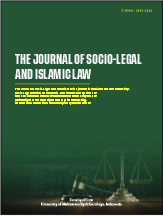Analysis of China's 9-Dash Line Claim in the South China Sea Under International Law
DOI:
https://doi.org/10.30651/jssl.v2i2.22430Abstract
The South China Sea area is an area that has a lot of potential. Its very strategic role in various fields such as politics, economics, and security makes it the largest water area with great potential. It contains 266 trillion cubic feet of gas reserves and 7.7 billion barrels of oil reserves. This is the cause of the dispute that occurred in the South China Sea (Luh Gede, et al 2022). There is a clash of diplomacy cultures between ASEAN with the "ASEAN Way" which upholds the principles of non-intervention and consensus and China with direct diplomacy efforts to related countries. (Ali Maksum 2017) The need for a large role from the government to make new, firmer policies to increase the strength of the sovereignty of the Republic of Indonesia. (Atikah, et al 2021) The importance of peace diplomacy efforts at the bilateral, regional level can be focused on efforts to resolve the South China Sea dispute. (Yuli, et al 2021) The need for China to respect the decision of the Permanent Court of Arbitration (PCA) so that it can be resolved in a peaceful manner. (Dessy, et al 2018). This research will focus on (1) What types of violations of state sovereignty committed by China over the South China Sea claims and (2) How dispute resolution efforts can be taken by the South China Sea region countries and the UN according to UNCLOS 1982. This research method adopts quantitative and qualitative research methods from various social sciences and sees legal issues as a social event. The results in this study show that the dispute over the South China Sea region between China and the country sliced by the Nine Dash Line map still does not show a bright spot and the existing disputes will continue to recur and develop over time due to differences in principles between the parties to the dispute. On the one hand, China sticks to historical theory, while other countries that are sliced also use historical theory which is also accompanied by the determination of territorial boundaries contained in UNCLOS 1982. In this case, good faith between countries is needed by making mediation efforts in order to reach a peaceful agreement. However, if this is still deemed unable to resolve the existing dispute, then another step that can be used is through the decision of the International Court of Justice (ICJ).
Downloads
Published
How to Cite
Issue
Section
License
Copyright (c) 2024 Muhammad Ibrahim Akbar

This work is licensed under a Creative Commons Attribution 4.0 International License.






